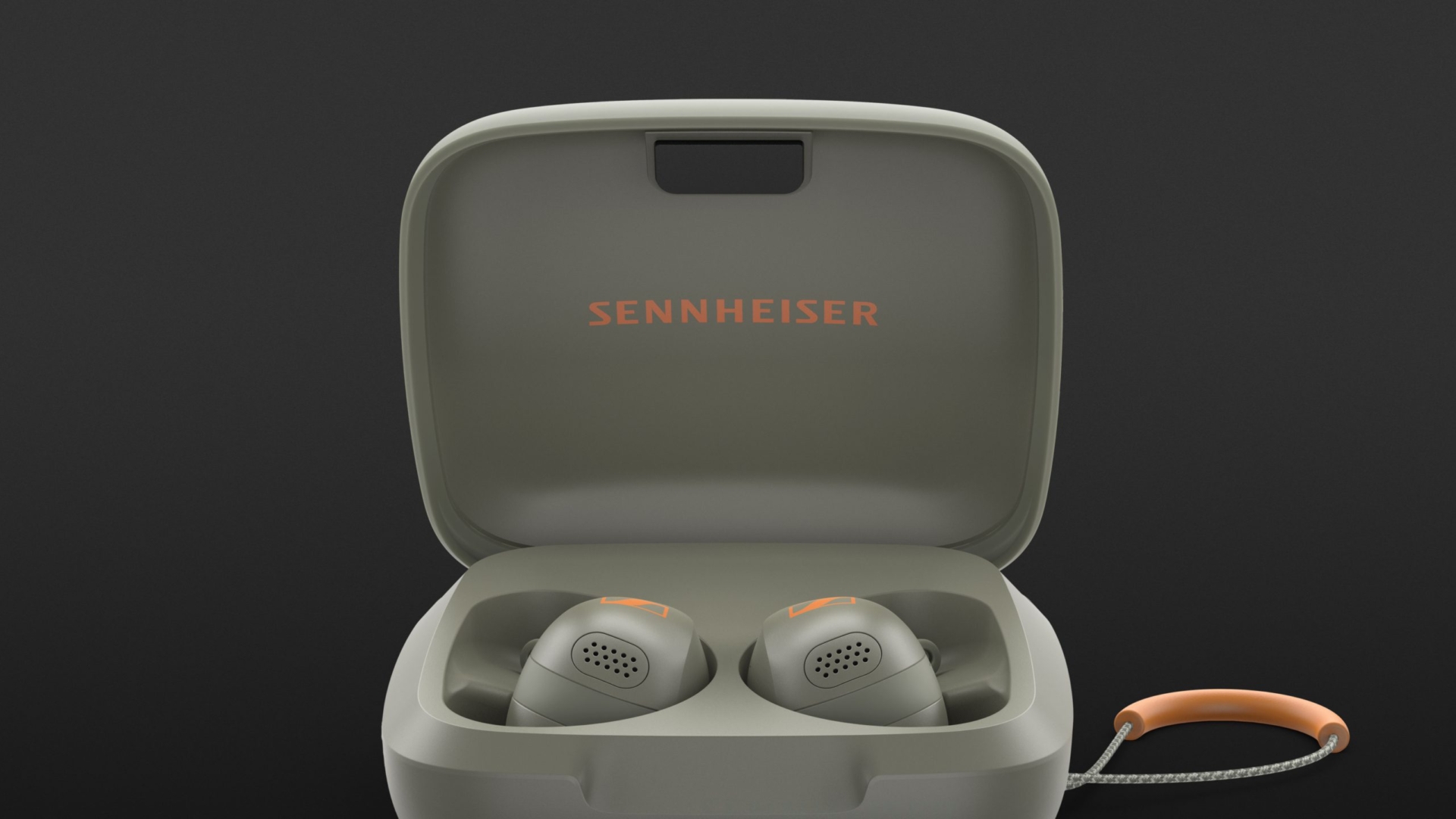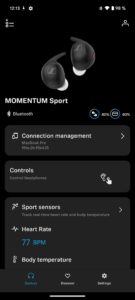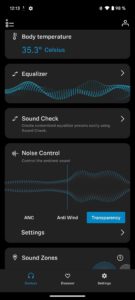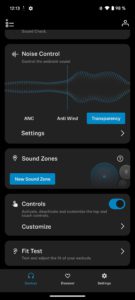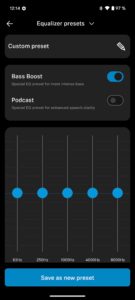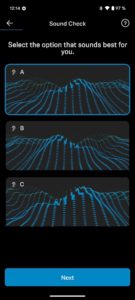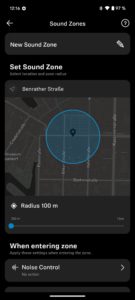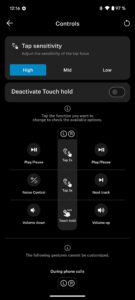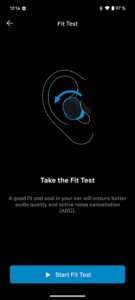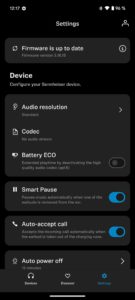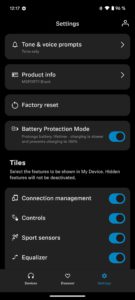If you are looking for headphones that not only impress with good sound, ANC and transparency mode during your daily fitness routine but also record data such as heart rate and body temperature via fitness apps, the Sennheiser Momentum Sport are high-quality in-ears. However, these new German superstars are not perfect.
- Sound
- Noise cancelling
- High-quality codecs
- Heart rate and temperature measurement
- Wearing comfort
- Error-prone controls
- Auto-pause function lacks precision
- Quite expensive
The Momentum Sport are the manufacturer’s new top model in the “fitness earphones” category, and replace the Sennheiser SPORT True Wireless that we tested two years ago.
The new Momentum Sport aim to combine the familiar Sennheiser sound with versatile features such as real-time biometric feedback for fitness enthusiasts. The headphones integrate both a photoplethysmography (PPG) heart rate sensor and a body temperature sensor, which can transmit important measurement data to fitness apps and devices. This data can, therefore, be seamlessly connected and integrated with sports devices and apps such as Apple Watch/Health, Garmin Watch/Connect, Strava, Peloton and many more. The well-known fitness tracker company Polar has even gone one step further: for the first time in a product not made by Polar, you can get full access to the biosensor functions and data analyses via the Polar Flow app ecosystem. Although the Sennheiser Momentum Sport tracks heart rate and temperature, a third-party app is required to record and process this data.
Clever technology – the Sennheiser Momentum Sport in detail
A problem with many headphones: footstep reverberation – a noise that occurs when in-ears are too tight in your ear. The resulting closed resonance chamber amplifies your own footsteps, rustling clothes, or even breathing noises. This can be particularly distracting when running. To minimise these distractions, the Momentum Sport have an acoustic relief channel and a semi-open design to enable a more natural perception of your surroundings.
In practice, this design solution proves to be effective. Your own footsteps were muffled during media playback and are not distracting; the rustling of a thick woollen hat was not completely suppressed, but we had no reason to complain.
Adjustable transparency, anti-wind and adaptive noise cancellation modes allow you to easily adapt to changes in the environment.
If you want to use the headphones without active circuits, you can only do so with the help of the Sennheiser app. In contrast to their hi-fi counterparts, the Sennheiser Momentum True Wireless 4, the Momentum Sport lacked a dedicated off switch to deactivate the ANC and transparency mode. Therefore, the transparency mode slider must be set to “minimum” with a swipe of your finger so that you do not hear either noise cancellation or Aware mode in operation.
According to the manufacturer, the completely new acoustic system also features a redesigned transducer that aims to deliver the best sound quality from Sennheiser sports earphones to date. But more on that later.
There has also been an update to the look of these headphones. The characteristic angular design of the Momentum True Wireless series has given way to a rounded shape, and there is also a new design for the case. While the Momentum True Wireless 4 are now also available in white in addition to two dark colours, the Momentum Sport are “only” available in the three subtle colours – black, dark grey and olive green with an orange manufacturer’s logo.
The package
Headphones for sporting activities need one thing above all else: a perfect fit. To ensure this, the manufacturer not only includes three pairs of (transparent) silicone ear adapters but also four pairs of ear fins that provide additional support in your ears. Attaching these is a little fiddly and, unfortunately, only becomes intuitive after a few attempts.
There is also a 40cm USB-A to C charging cable and a small carrying strap that can be attached to the side of the charging case.
With its dimensions of 67.7 x 64.8 x 30.0mm, the case is not one of the smallest on the market, but thanks to IPX4 protection and an all-over rubber coating, it is robust and can withstand moisture. Unfortunately, this type of rubber protection has a disadvantage: fluff, dust and hair adhere to these surfaces very well and very readily. Only time will tell how long this rubber, which also functions as the case’s hinge, will guarantee functionality. And finally, another point of criticism: the rubber hinge means that the case lid has lateral play, so if it is closed too hastily, it may not shut properly and the IPX protection may be cancelled out.
A small, inconspicuous LED on the front provides information about the charge status; unlike most of the competitors, the LED does not go out after a defined time if you forget to close the case. This was also what happened with the Sennheiser Momentum True Wireless 4, which we recently tested.
The in-ears (IPX5 protection) themselves have a bean-shaped design and a high-quality finish. However, the hard plastic casing tended to slip out of my fingers if my hands were too dry.
Bluetooth and battery life
Thanks to Bluetooth version 5.2, the pairing was quick and easy: Just insert the earphones in your ears, press the touch surfaces for three seconds, select in the player’s settings – and you’re connected.
The Sennheiser Momentum Sport support two Bluetooth wireless technologies: Bluetooth Classic and Bluetooth Low Energy. The latter connects the headphones to fitness devices and apps (including the Sennheiser Smart Control app for iOS). Classic, on the other hand, is responsible for audio playback, making phone calls and using the Smart Control app on devices with an Android operating system.
The earphones can simultaneously establish two connections via Bluetooth Classic and two additional connections via Bluetooth Low Energy (multipoint function).
The Sennheiser Momentum Sport support SBC, AAC, aptX and aptX Adaptive codecs.
In our practical test, these sports headphones achieved very good values in conjunction with a smartphone: In an open space, the drop-outs only occurred after approx. 35 metres; indoors inside my flat, I had to change floors before I heard any drop-outs. Connected to a MacBook Pro, I heard drop-outs after about 10 metres – which is typical with the weaker Bluetooth chips of older Macs.
With 5.5 hours of playback time and an additional 18.5 hours of battery life via the charging case, I achieved a total runtime of 24 hours. After approx. 1.5 hours, the earbuds were back to one hundred per cent, while a short ten-minute recharge resulted in an approximate runtime of 45 minutes. The case could also be refuelled wirelessly.
Operation of the Sennheiser Momentum Sport
The in-ears, which also support single-sided use in single mode, are controlled via two functions, “Touch Control” and “Tap Control”. “Touch Control” means classic operation by tapping the earphones. Thanks to sensors, “Tap Control” also supports control via finger gestures in the vicinity of each of the earphones, i.e. in front of the ear or on a hat covering the earphones. However, this required practice, as the headphones did not always recognise the commands, so a triple tap, for example, was often interpreted as a double tap, which then paused media playback instead of switching on the ANC. A firmware update (V 3.18.15) brought a noticeable improvement, but this type of control is still not 100 per cent reliable. Although the sensitivity can be adjusted in the app, something which I found provided an improvement, the in-ears then reacted quite sensitively to my touch.
Other than these hiccups, the headphones offered standard fare in terms of control options: play/pause, track control, volume, call handling, ANC/transparency. You can also customise these to a certain extent via the app. It should be noted that single tapping is not supported, probably to avoid incorrect commands.
These in-ears also have a wear detection function, including an auto-pause function, but this lacked precision. For example, if you place them on the table with the insides facing you, they simply keep on playing which, of course, has a negative impact on the battery life.
Smart Control App
The well-made app also serves as a kind of hub for all Sennheiser products that can connect to a smartphone via Bluetooth. If you own several pairs of Momentum or other compatible Sennheiser hardware, Smart Control offers you convenient management of these headphone models.
Not only can you carry out firmware updates, but you can also remap the touch surfaces (including touch sensitivity). A simple five-band EQ is used for sound tuning, or you can select a suitable EQ curve from eight pre-sets. These can be edited and saved.
The app also includes a special EQ pre-set for more intense bass and one for podcasts, which ensures better speech intelligibility by boosting the mid-range.
In addition to battery-saving charging functions, the app offers a “Sound Check” where you can click through several EQ curves while your favourite music is playing. You can save the final results and retrieve them as often as you like. This requires a free account with Sennheiser but this then enables you to use your own EQ settings and sound zones across all devices.
Sound zones allow you to define how the headphones behave when you enter or leave defined locations. If you want noise cancelling, including individual EQ settings, to be activated as soon as you leave the house, you can configure this accordingly.
Heart rate and temperature measurement
The sensors for measuring the heart rate and body temperature are located in the left earpiece. These values are then displayed in real time in the Smart Control app. Unfortunately, due to a lack of reference devices, we were unable to provide a satisfactory answer about how precisely the measurements were taken. We were simply not equipped for this on the editorial team. However, a comparison with the Apple Watch and a Huawei fitness wristband showed similar results. Measuring the heart rate in the ear is definitely more precise than on the wrist. Sennheiser states an accuracy of 0.3 degrees Celsius for temperature measurement.
The manufacturer emphasises that in this context, these values are intended exclusively for fitness and wellness and not for medical purposes.
If you want to use the data to set training goals or track your fitness level, you need to link the headphones to the Polar Flow app, which is also free. Those of you who prefer not to use a smartphone during training sessions can also link the Momentum Sport directly to an Apple Watch or other trackers and sports watches. Stationary fitness devices such as Peloton are also compatible with these headphones.
Connection with the Polar Flow app was easy, and after a few seconds, real-time body temperature and heart rate data appeared in the top bar. However, if you then want to complete a fitness test, you will be disappointed because you cannot start it despite the link to the HR sensor. If you click on the link that is supposed to lead to a list of supported sensors, you will unfortunately learn little or nothing about it.
Sound of the Sennheiser Momentum Sport
Sennheiser has installed a new sound transducer in its Momentum Sport, which, with a diameter of 10mm, is larger than in its top hi-fi model Momentum True Wireless 4 (here: 7mm). Indeed, the Sport version did sound different.
There was hardly anything to complain about here, although the following sound assessment was carried out without the use of an equaliser.
The bass range was reproduced as tonally comprehensible and provided a precise, warm, but still quite discreet foundation. So if you want to be driven by pumping beats during your workout, these headphones were pretty reliable, but you may have to make the settings yourself: If you want to push the low end even further to create a fat bass, you can use the bass boost switch in the app. The headphones will then increase in volume but are still a long way from having a really booming bass. If you raise the EQ’s 63 Hz control, the drivers start to audibly work up a sweat and the mids and highs start to hum noticeably. You can hear the typical compression when the rest of the sound is de-energised, and this manifests itself in a slight but still perceptible reduction in volume (e.g. when listening to Blue Man Group’s “Piano Smasher”).
The mids were clear and were able to reproduce voices and instruments cleanly. Lead guitars or synths did not cut into the ears and the highs also seemed slightly reduced, which prevented premature listening fatigue. Incidentally, unlike the Momentum True Wireless 4, the highs did not have a tendency to become harsh when the headphones were turned up to over 85 per cent of the volume.
Noise cancelling and transparency mode
The adaptive, hybrid noise cancelling worked at a high level and filtered out static, working on low-pitched noises in particular. Voices and high-frequency signal components penetrated as attenuated. These headphones were therefore in a similar league to the Apple AirPods Pro 2 and their stablemates the Momentum True Wireless 4.
The anti-wind function also performed very well, even if you should not expect miracles in the form of complete cancellation. A light breeze was hardly noticeable, but even if it was blowing more strongly around your ears, the Momentum Sport could still significantly reduce the noise.
The background noise was not noticeable during media playback; only when transparency mode was activated did it become clearly audible, but it was somewhat lower than with the Momentum True Wireless 4, which we criticised in our review at the time. When listening to music, the external perception could have been higher for our taste, even when maximum transparency was engaged.
One solution that was a little better implemented here than with the Momentum True Wireless 4: It is possible to switch between ANC, anti-wind and transparency mode on the Momentum Sport.
Conclusion
The Sennheiser Momentum Sport are high-quality headphones that are aimed primarily at sports enthusiasts who are specifically working on their fitness. These headphones also offer relatively accurate heart and temperature measurements, including integration with all relevant fitness apps and tools.
Both in terms of sound and ANC, we can hardly criticise the Momentum Sport, but the controls of these in-ears should be more reliable.
With an RRP of 329.90 euros, the Sennheiser Momentum Sport are at the upper end of the price range. It is therefore important to carefully consider whether you really need to have heart rate and temperature measurements from your headphones.
Technical specifications
- Ear couplingIn-ear
- Typesemi-open
- Transducer principledynamic
- Frequency response (headphones)15 - 18.000 Hz
- Sound pressure level (SPL)@ 1 kHz/0 dBFS: 110 dB
- Weight without cable6.4g each, case 78.4 g
- Cable length40 cm
What's in the box
- Ear adapter sets (N/S/M/L)
- Ear fin set (S/M/L)
- USB-C charging cable
- Charging case with carrying strap
Special features
- Available in black, grey and olive green
- BT version: 5.2
- BT codecs: SBC, AAC, aptX, aptX Adaptive
- BT profiles: A2DP, AVRCP, HFP









